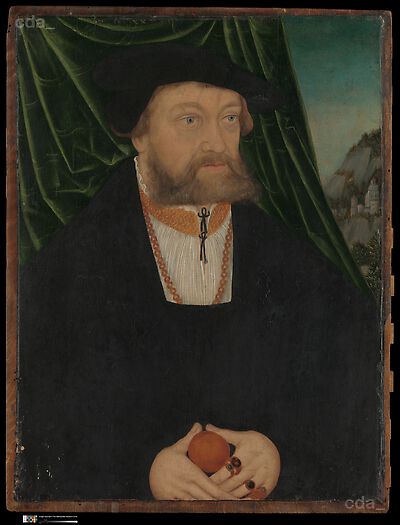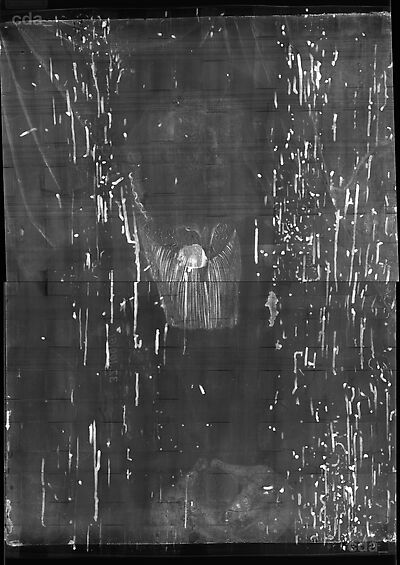This portrait appeared in two dealers’ exhibitions in New York in the late 1920s, where it was attributed to Lucas Cranach the Elder on the advice of Max J. Friedländer and Wilhelm Valentiner.[1] In their 1932 catalogue raisonné of Cranach’s paintings, however, Friedländer and Jakob Rosenberg recognized a divergence from the style of Cranach himself and attributed this portrait along with four others to the Master of the Masses of Saint Gregory (Meister der Gregorsmessen), a painter from Cranach’s studio who worked extensively for Cardinal Albrecht of Brandenburg.[2] The Metropolitan Museum’s internal cataloguing from 1947 onward situated the portrait within the Cranach workshop.[3] Andreas Tacke upheld Friedländer and Rosenberg’s attribution to the Master of the Masses of Saint Gregory, whom Tacke proposed to identify as the painter Simon Franck, who is documented in the service of Albrecht of Brandenburg.[4] Isolde Lübbeke, however, pointed out significant stylistic differences between the name paintings of the Master of the Masses of Saint Gregory and the group of portraits that includes this one. Maintaining rightly that the “exaggerated plasticity” of the Mass of Saint Gregory pictures is inconsistent with the style of the portrait group, she reassigned the latter, to which she added further examples, to an anonymous painter in Cranach’s circle.[5] Technical examination of the present work (see technical notes) shows furthermore that some aspects of the paint layering, for example in the curtain and the finger rings, are uncharacteristic of standard practices of the Cranach workshop.
The group of portraits to which the Metropolitan Museum’s panel belongs now consists of at least ten known works spanning the second quarter of the sixteenth century (1525 – 48), which show a remarkable consistency of style and composition.[6] Although the artist was clearly influenced by the style of Cranach, portraits produced by the Cranach workshop exhibit a greater variety of pose, expression, and motifs. As Lübbeke noted, the almost unwavering adherence to a strict formula suggests a painter operating independently of Cranach. Without exception, the sitters in these works strike a rigidly upright pose. Their hands are almost always crossed one over the other, but rarely are they actually folded together. The expressions tend to be wide-eyed and vacuous. In the early portraits, the sitters’ irises are nearly covered by exaggerated windowpane catchlights, but beginning in the 1530s those reflections diminish or no longer appear. Frequently, as in the Museum’s portrait, the garments are fastened at the neck with black bows. In the earliest works, a green curtain covers the whole background; from 1528 onward, the curtain is pulled aside to reveal a landscape. The artist’s treatment of forms initially displayed a certain smoothness and softness, which in the 1530s gave way to a harder, more severely linear style. In the Museum’s portrait, which belongs to the later period, the impression of hardness and flatness is exaggerated by extensive abrasion of the paint layers.
The artist responsible for these portraits appears to have remained active within the regional orbit of Cranach, for the one identified sitter in the group is the University of Leipzig professor Heinrich Stromer.[7] The unidentified painter may have had a career comparable to that of Antonius Heusler, who, after presumably training under Cranach, established himself independently in the mining town of Annaberg, in Saxony, in 1525.[8]
[1]New York 1928, p. 18, no. 32; New York 1929, p. 8, no. 23. The opinions (Max J. Friedländer, Berlin, April 29, 1927, and Berlin, February 16, 1928; Wilhelm R. Valentiner, Detroit, March 8, 1928) are preserved on the backs of old photographs (curatorial files, Department of European Paintings, MMA).
[2] Friedländer and J. Rosenberg 1932, p. 98, no. 367; Friedländer and J. Rosenberg 1978, p. 162, no. Sup 17. The four other portraits are Friedländer and J. Rosenberg 1932, p. 98, nos. 365 (two paintings), 366, 368 (Friedländer and J. Rosenberg 1978, pp. 161 – 62, nos. Sup 15, 15A, 16, 18). The attribution is repeated by Kuhn in [Exhib. Cat. Cambridge Mass. 1936, p. 44, no. 144.]
For the name paintings of the Master of the Masses of Saint Gregory now in the Staatsgalerie Aschaffenburg and the Stiftskirche, Aschaffenburg (Bayerische Staatsgemäldesammlungen, inv. nos. 6270, 6271), see Friedländer and J. Rosenberg 1978, p. 161, nos. Sup 11, Sup 12, ill.; Martin Schawe in [Exhib. Cat. Aschaffenburg 2007, pp. 270 – 71, 273, 306 – 8, nos. 14, 51, ill.]
[3] Wehle and Salinger in [Cat. New York 1947, pp. 206 – 7]; Baetjer in [Cat. New York 1980, vol. 1, p. 37]; Baetjer [Cat. New York 1995, p. 223].
[4] Tacke 1992, pp. 62 – 63.
[5] Lübbeke 1991, p. 64.
[6] Portrait of a Woman Aged Twenty-Six, 1525, Museo Thyssen-Bornemisza, Madrid (Friedländer and J. Rosenberg 1978, p. 161, no. Sup 15A); Portrait of a Man Aged Twenty-Nine, 1526, private collection (Friedländer and J. Rosenberg 1978, p. 161, no. Sup 15, ill., showing state before strip cut off bottom, removing hands; Sotheby’s, London, July 6, 2000, no. 4; Koller, Zürich, March 27, 2009, no. 3008); Portrait of a Man Aged Thirty-Six, 1526, Suermondt-Ludwig-Museum, Aachen (Lübbeke 1991, p. 64, n. 2); Heinrich Stromer, 1527, private collection (Friedländer and J. Rosenberg 1978, p. 162, no. Sup 16, ill.); Portrait of a Man with a Floral Diadem, 1527, private collection (Christie’s, London, July 8, 2008, no. 11); Portrait of a Woman Aged Twenty-Two, 1528, Scottish National Gallery, Edinburgh (Lübbeke 1991, p. 64, fig. 1); Portrait of a Man Aged Fifty-Seven, 1541, Portrait of a Woman Aged Thirty-Nine, 1538, a pair, State Hermitage Museum, Saint Petersburg; Portrait of a Man Aged Forty-One, 1543, private collection (Friedländer and J. Rosenberg 1978, p. 162, no. Sup 18, ill.); Portrait of a Man Aged Thirty-Nine, Portrait of a Woman Aged Twenty-Eight, 1544, a pair, private collection (Sotheby’s, London, July 6, 2000, no. 11; formerly Wallraf-Richartz-Museum, Cologne); Portrait of a Woman Aged Twenty-Six, 1548, private collection (London 1906, no. 4, pl. xxiv; acquired by the Metropolitan Museum in 1922, acc. no. 22.60.48, and deaccessioned in 1933). The portraits are of nearly the same size, with the exception of the female likeness in Madrid, which is somewhat taller and narrower than the rest.
[7] See, for example, the initials HSD (for Heinrich Stromer, Doctor) on the background and, in mirror image, on the signet ring of Heinrich Stromer, a portrait of 1527 by the same artist (private collection; Friedländer and J. Rosenberg 1978, p. 162, no. Sup 16; See also Dieter Koepplin in [Exhib. Cat. Basel 1974, vol. 2, p. 693, no. 617].
[8] On Heusler and other Cranach pupils, see Emmendörffer 1998, pp. 219 – 22 and passim, with references to earlier literature.
[Waterman, Cat. New York 2013, 88, 90, 292, No. 19]



